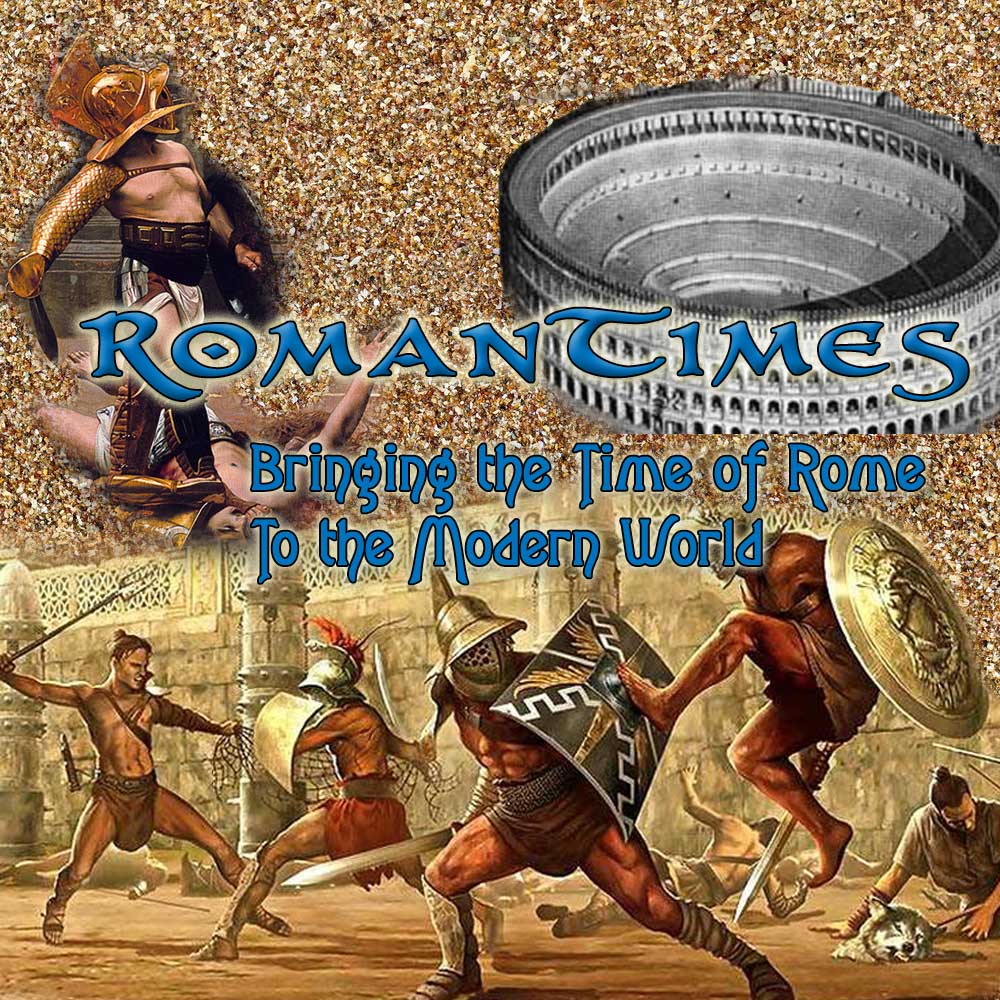Gladiators and the Arena
The Entertainment and Games of Rome
Part of RomanTimes is an opportunity to reenact other aspects of Roman life and as such, we encourage those interested in Roman Gladiators to join. In this area, you will find information about Roman Gladiators and reenacting this area of history.
Information on Gladiatorial Combat and the Great Colosseum and maybe some answers to questions you did not know to ask.
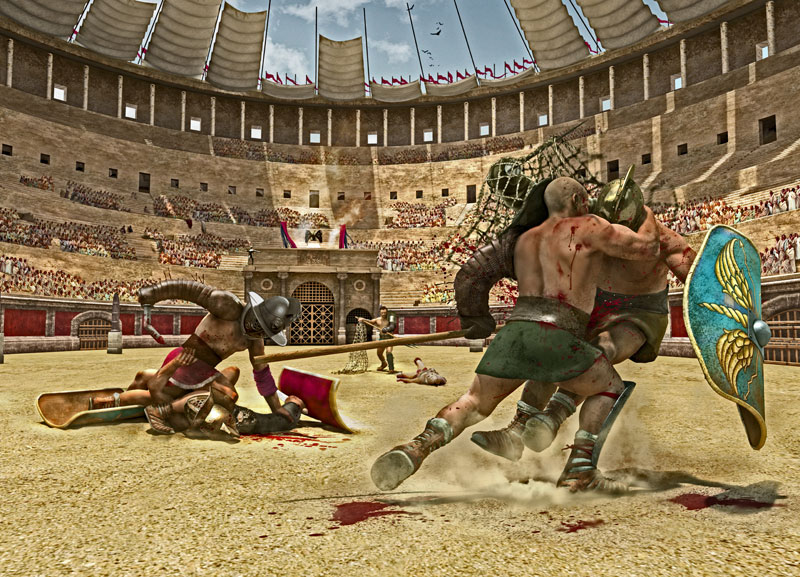
About
Most people have heard of the gladiators and many have seen the movie of that name. For many reenactors, that was the movie that got them into Ancient Reenacting. But as to the real gladiators, what do you know? Things aren't quite as they seem in the movies. A gladiator (Latin: gladiator=swordsman, from gladius=sword) was a combatant who entertained audiences with live combat, often to the death, during the Roman Republic and Roman Empire. These gladiators often fought against other gladiators, wild animals, and condemned criminals.
Some gladiators were volunteers who risked their lives and their legal and social standing by appearing in the arena. Most were despised as slaves, schooled under harsh conditions, socially marginalized, and segregated even in death. Irrespective of their origin, gladiators offered spectators an example of Rome's martial ethics and, in fighting or dying well, they could inspire admiration and popular acclaim. Gladiators were celebrated in high and low art, and their value as entertainers was commemorated in precious and commonplace objects throughout the Roman world.
Origins
Gladiatorial Games were Etruscan in origin during Etruscan funeral masses, two warriors cimages/alled bustiarius would fight over the grave of the deceased, in a display to honor the dead. This Etruscan tradition later came to Rome, also as a funeral ceremony. At first, gladiatorial combat was only a matter of a few prisoners of war or criminals facing each other in contests staged at the funerals of distinguished Romans. As time went on, these small events grew...
Bread and Circuses
Events were also staged involving animal combat and beast hunts or Venatio, to honor the gods Flora and Ceres with chariot races becoming popular during festivals in honor of the god Mars and had the winning horse sacrificed. By the time of Julius Caesar, any connection of these brutal contests with funerals and religious festivals was long gone, as they had become public spectacles similar to our modern football games, rodeos, boxing and wrestling matches something to distract the masses (some things remain the same).
Ludi
The greatest number of "Games" (Ludi) were staged under the rule of Emperor Augustus (r: 27BC-14AD). During this time, a long period of peace had caused the masses to grow increasingly bored and restless. This was worrisome to Augustus because if they were restless, they might rebel To calm the people, more games were put on the spectacle of the "Games" helped to remind the people of Rome of the victorious battles that had brought the Empire to her glory. Also, the brutality of the arena may have made the lives of the common people seem easier and less severe by omparison. To us, gladiatorial events may now seem repulsive; but for the people of Ancient Rome, the "Games" were something they loved and needed it was a different mind-set and society... "When in Rome..."
Bestiarium
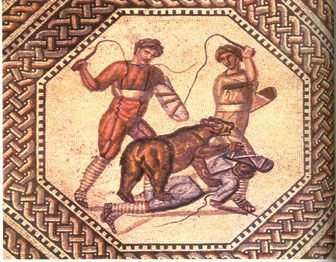 The "Animal" (Venatio/Bestiarium) events were meant to reinforce the belief in the superiority of Man (and Rome) over beasts and nature; while the Gladiatorial Combats demonstrated the courageous virtues of the Roman Soldier, and of Rome itself.
The "Animal" (Venatio/Bestiarium) events were meant to reinforce the belief in the superiority of Man (and Rome) over beasts and nature; while the Gladiatorial Combats demonstrated the courageous virtues of the Roman Soldier, and of Rome itself.
The popularity of these cruel spectacles was such that, by the time they were abolished in AD 523 during the consulship of Flavius Anicius Maximus, tens of thousands of animals had died, and entire species were no longer to be found in their native habitat all having been captured or driven away. There were no more hippopotamuses in Nubia or elephants in northern Africa; the lions which once had been represented in Assyrian reliefs were gone. Either five thousand or ten thousand animals were reported to have died in the dedication of the Colosseum; eleven thousand died in the celebration of Trajan's conquest of Dacia; and Augustus boasted that, in the twenty-six venationes presented in his reign, thirty-five hundred animals had been killed. When Pompey presented elephants (and the first rhinoceros) at the Circus Maximus, he did so in part to demonstrate his power over even the strongest of beasts.
Another Prize
During the Games, numbered wooden balls "missilia" would be thrown out to spectators during games at the Colosseium. These wooden balls would be marked and then could be redeemed for valuable and luxurious prizes. Prizes can include slaves, food for the family, money, and public recognition (one of the most coveted prizes>).[more...]
Long Lived
The gladiator games lasted for nearly a thousand years, reaching their peak between the 1st century BC and the 2nd century AD. The games finally were ended by Emperor Theodosius in 393 after the adoption of Christianity as the state religion of the Roman Empire in 380, although beast hunts (venationes) continued into the 6th century.
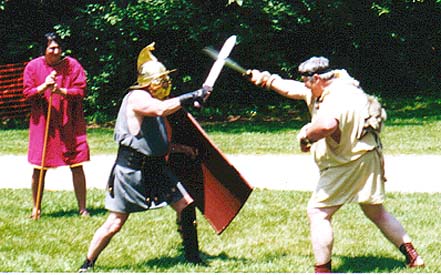
John Ebel (Maximus) confronts Michael Catellier (Lupus), at the Roman Days
encampment in Glendale, MD, on June 9, 2001.
Maximus Wants You! in his Gladiatorium Academia.
Gladiator's Status
Many gladiators used, or were given nicknames; which helped to mask their less than professionals, some were slaves, many were captives and prisoners of war; but together in combat in the amphitheaters and arenas they became symbols of Rome's control over the ancient world. More...
Other Types of Death in the Ring
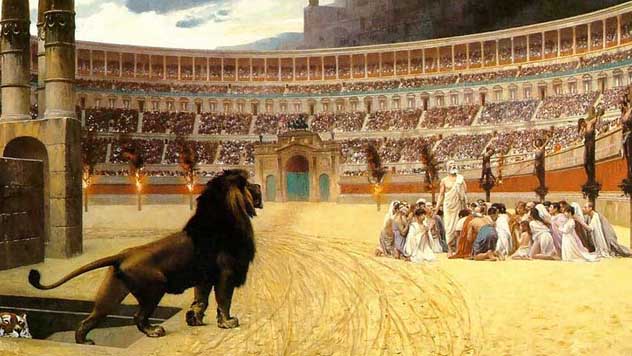
Not to be confused with the gladiatorial games (munus gladiatorium) and their exhibition of combat, was the execution of criminals (noxii) and others charged with the most serious offences. Condemned damnatio (to die as a lesson to others), they were brutally killed (necare) in the most public of spaces, the circuses and amphitheaters. In front of tens of thousands of spectators, they were burnt (comburere), crucified (cruce suffregeri), put to the sword (damnati ad gladium), exposed defenseless to the savagery of wild beasts (damnati ad bestius) or as untrained slaves or criminals (gladiatores meridiani) were forced to fight and execute one another. Many of these were Christians, who faced death for the treasonable offence of refusing to sacrifice to the will of the Emperor, thereby rejecting the Roman and state-sanctioned religion of Paganism. Noxii could also be sentenced to a gladiator school "damnati in ludum" to be trained to fight (and probably die) in the Arena.>
Their Fate
As a "Thracian" was set against a "Mirmillo" and a "Secutor" faced a "Retiarius" in these contests of life and death, their fate was often determined by a gesture of the Emperor's hand; which itself, might be influenced by the verdict of the crowd. The spectators expected and applauded a close-fought and exciting battle; which demonstrated the Roman affection for warlike spirit and courage. Bravery was the foremost virtue of the Romans, who valued military service above the athletic achievements of the Greeks. Gladiatorial combat focused public attention on the ultimate expression for a Roman man: That of Courage, Stoicism and Bravery.
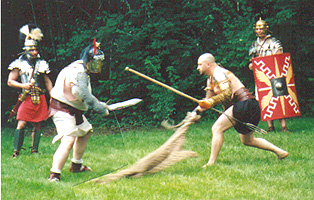
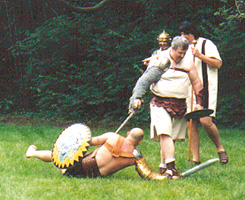
During Roman Days — 2003, the Barbarian "Wolf of Britain" (left) was confronted by "Retiarius" styled Aulus Scipio Barbatus. The "Wolf" came out victorious. Barbatus, survived however, to later avenge his defeat.

